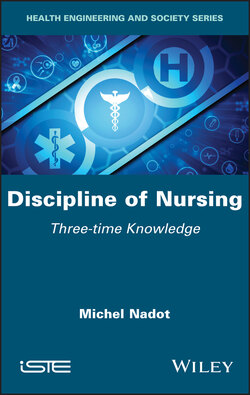Discipline of Nursing

Реклама. ООО «ЛитРес», ИНН: 7719571260.
Оглавление
Michel Nadot. Discipline of Nursing
Table of Contents
List of Illustrations
List of Tables
Guide
Pages
Discipline of Nursing. Three-time Knowledge
Foreword
Preface
Introduction
1. Role of History. 1.1. Lay knowledge
1.2. A difficult history for an ordinary experience
2. The Hospital as a Place to Talk
2.1. The origin of the hospital
2.2. The care environment
3. Care Before 1850
3.1. Maison staff
3.2. Sacred values in the period of lay knowledge
Box 3.1.Planned job description for nurses in 1771 in the Freiburg hospital (Switzerland)
Box 3.2.Excerpt from the Règle 1784 of the Sisters of Sainte-Marthe de Beaune for the large hospital in Freiburg, Switzerland
3.3. Nurses (enfermières)
3.4. Nurses and gardes-malades
3.5. City physicians
4. Practices and Knowledge
4.1. Domus or looking after property life
4.2. Hominem or looking after human life
4.3. Familia or looking after group life
4.4. Never enough time to do everything
5. A Return to Image: Minion Syndrome
5.1. Even more knowledge
5.2. The economically unnecessary provision of services
6. From Hospital-School to School-Hospital
6.1. A non-religious form of training
6.1.1. Valérie de Gasparin. Box 6.1.Brief biography of Valérie de Gasparin
6.2. Valérie de Gasparin and Florence Nightingale
7. The Advent of Medical Writing
7.1. The ERR process for practical knowledge
7.2. Nursing students and writing
8. Towards Higher Education
8.1. Women’s groups
8.2. Non-university higher education structures
8.3. Towards university schools and scientific research
8.4. Europe and the Hautes écoles spécialisées (HES)
9. A Return to Image: The Shaping of Knowledge
9.1. Duplication of reduced knowledge
9.2. The problematic identity of knowledge
10. Nursing Sciences?
10.1. Profession first, discipline and science second!
10.2. Historical constants of the discipline
10.2.1. Domus–familia–(ad)hominem
10.2.2. Three cultural and linguistic systems
10.2.3. Medium, mediation, cultural intermediary
10.2.4. Concepts of the nursing disciplinary metaparadigm
10.2.5. Fourteen groups of practices
11. The Construction of the Discipline
11.1. The green knowledge theory
11.2. Compulsory basic knowledge
12. Identity and Discipline
12.1. Why health mediology?
12.2. The identity of our knowledge and health mediology
13. A Return to Image: “Where Do We Go Now”?
13.1. An intergenerational continuity of knowledge
13.2. Ordinary practices before advanced practices
Conclusion
References
Index. A, C, D
E, F, G
H, I, J
K, L, M
N, O, P, R
S, T, U, V
WILEY END USER LICENSE AGREEMENT
Отрывок из книги
Series Editor
.....
This is what makes this book innovative, a true disciplinary revolution, a call for a major paradigmatic change or better, a real conceptual clean-up to come. It calls for the construction of a clear status for the discipline, a distinct professional identity and a scientific discipline that only increases the credibility of the nursing profession, as well as the confidence of other healthcare professionals and, above all, of all the beneficiaries of the services provided by nurses in response to ever-increasing healthcare needs.
Finally, I conclude with Bachelard [BAC 83] who said that nothing is selfevident. Nothing is given, everything is built. This is the case with this book. So let us demystify and overcome the nursing myth that we currently know and build together the nursing sciences of the 21st Century!
.....